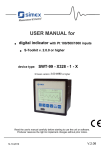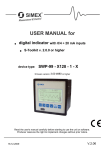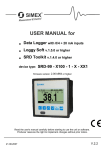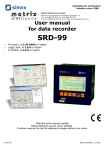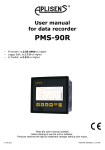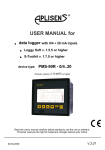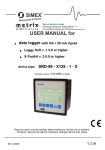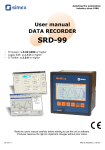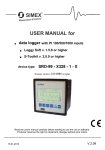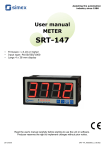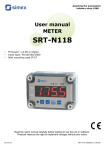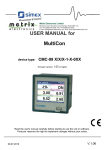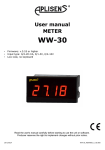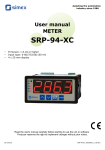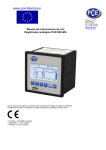Download SIMEX® USER MANUAL for
Transcript
®
SIMEX
USER MANUAL for
●
digital indicator with 0/4 ÷ 20 mA inputs
●
S-Toolkit v. 1.7.0 or higher
device type:
SWP-99 - X100 - 1 - X - XX1
firmware version: 2.10
b972 or higher
Read the user's manual carefully before starting to use the unit or software.
Producer reserves the right to implement changes without prior notice.
14.08.2008
V.2.05
User manual for Digital Indicator and cooperating software
CONTENTS
I. USER MANUAL FOR “SWP-99” DIGITAL INDICATOR..........................................4
1. BASIC REQUIREMENTS AND USER SAFETY........................................................................................4
2. GENERAL CHARACTERISTICS................................................................................................................5
3. TECHNICAL DATA......................................................................................................................................6
4. DEVICE INSTALLATION............................................................................................................................8
4.1. UNPACKING.......................................................................................................................................8
4.2. ASSEMBLY........................................................................................................................................8
4.3. CONNECTION METHOD.................................................................................................................11
4.4. MAINTENANCE................................................................................................................................14
5. FRONT PANEL DESCRIPTION................................................................................................................15
6. PRINCIPLE OF OPERATION...................................................................................................................16
6.1. MEASUREMENT MODE..................................................................................................................16
6.2. MODES OF RESULT PRESENTATION..........................................................................................17
6.2.1. "Single channel" mode............................................................................................................17
6.2.2.”Graph” mode...........................................................................................................................19
6.2.3.”Channels List” mode...............................................................................................................21
7. DEVICE PROGRAMMING.........................................................................................................................22
7.1. PARAMETERS EDITION.................................................................................................................24
7.1.1.Numeric and switching parameters ("LIST" - type)..................................................................24
7.1.2. Text parameters......................................................................................................................25
7.1.3.“SLIDER” - type parameters.....................................................................................................26
7.2. DESCRIPTION OF RESULTS PRESENTATION MODES MENU.................................................27
7.2.1.”Graph options” menu..............................................................................................................27
7.2.2.”Channels list options” menu....................................................................................................27
7.3. RESULTS PRESENTATION MODES MENU STRUCTURE..........................................................28
7.4. MAIN MENU DESCRIPTION...........................................................................................................28
7.4.1.”Device information” menu.......................................................................................................28
7.4.2.”Display options” menu............................................................................................................28
7.4.3.”Input settings” menu...............................................................................................................29
7.4.4.”Date & time settings” menu....................................................................................................31
7.4.5.”RS485 port settings” menu.....................................................................................................31
7.4.6.”Access setup” menu...............................................................................................................33
7.4.7.”Language” parameter..............................................................................................................33
7.5. MAIN MENU STRUCTURE..............................................................................................................34
8. THE MODBUS PROTOCOL HANDLING.................................................................................................35
8.1. LIST OF REGISTERS......................................................................................................................35
8.2. TRANSMISSION ERRORS HANDLING..........................................................................................37
8.3. EXAMPLES OF QUERY/ANSWER FRAMES.................................................................................38
9. USER'S SETTINGS LIST..........................................................................................................................41
II. USER MANUAL FOR “S-TOOLKIT”.....................................................................45
1. GENERAL CHARACTERISTICS..............................................................................................................45
2. INSTALLATION AND STARTUP..............................................................................................................45
3. USING PROGRAM....................................................................................................................................46
3.1. “INPUTS SETTINGS” TAB...............................................................................................................47
3.2. “LOGGING SETUP” TAB.................................................................................................................48
3.3. “INTERFACE OPTIONS” TAB........................................................................................................49
3.4. “DEVICE INFORMATION” TAB.......................................................................................................50
3.5. CONFIGURATION MODES.............................................................................................................51
3.5.1.Individual configuration of channels.........................................................................................51
3.5.2.Configuring selected channels.................................................................................................51
2
User manual for Digital Indicator and cooperating software
3.5.3.Configuring all channels...........................................................................................................51
3.6. UPDATING SOFTWARE OF SWP-99 DEVICE..............................................................................52
Explanation of symbols used in the manual:
!
- This symbol denotes especially important guidelines concerning the installation and
operation of the device. Not complying with the guidelines denoted by this symbol
may cause an accident, damage or equipment destruction.
IF THE DEVICE IS NOT USED ACCORDING TO THE MANUAL THE USER IS
RESPONSIBLE FOR POSSIBLE DAMAGES.
i
- This symbol denotes especially important characteristics of the unit.
Read any information regarding this symbol carefully
3
User manual for Digital Indicator and cooperating software
I. USER MANUAL FOR “SWP-99” DIGITAL INDICATOR
1. BASIC REQUIREMENTS AND USER SAFETY
!
- The manufacturer is not responsible for any damages caused by
inappropriate installation, not maintaining the proper technical condition
and using the unit against its destination.
- Installation should be conducted by qualified personnel . During installation all
available safety requirements should be considered. The fitter is responsible for
executing the installation according to this manual, local safety and EMC
regulations.
- The unit must be properly set-up, according to the application. Incorrect
configuration can cause defective operation, which can lead to unit damage or
an accident.
- If in the case of a defect of unit operation there is a risk of a serious threat
to the safety of people or property additional, independent systems and
solutions to prevent such a threat must be used.
- The unit uses dangerous voltage that can cause a lethal accident. The unit
must be switched off and disconnected from the power supply prior to
starting installation of troubleshooting (in the case of malfunction).
- Neighbouring and mating equipment must meet the requirements of appropriate
standards and regulations concerning safety and be equipped with adequate
anti-overvoltage and anti-interference filters.
- Do not attempt to disassemble, repair or modify the unit yourself. The unit
has no user serviceable parts. Units, in which a defect was stated must be
disconnected and submitted for repairs at an authorized service centre.
!
- In order to minimize fire or electric shock hazard, the unit must be protected
against atmospheric precipitation and excessive humidity.
- Do not use the unit in areas threatened with excessive shocks, vibrations, dust,
humidity, corrosive gasses and oils.
- Do not use the unit in explosion hazard areas.
- Do not use the unit in areas with significant temperature variations, exposed to
condensation or icing.
- Do not use the unit in areas exposed to direct sunlight.
- Make sure that the ambient temperature (e.g. inside the control box) does not
exceed the recommended values. In such cases forced cooling of the unit must
be considered (e.g. by using a ventilator).
!
4
The unit is designed for operation in an industrial environment and must
not be used in a household environment or similar.
User manual for Digital Indicator and cooperating software
2. GENERAL CHARACTERISTICS
•
Multifunctional
SWP-99 designed for displaying current values and presentation of technological
parameter trends in graphic form. All measured parameters must be available in
0-20 mA or 4-20 mA (this can be for example pressures, levels, humidity,
temperatures, forces, etc.).
•
Configurable measurement and control input
The unit has up to 8 channels of 0-20 mA (4-20 mA) current signals. Each signal
can be freely configured and described. The internal analogue-digital converter has
a 12 bit resolution, which provides high measurement resolution results.
Additionally, individual alphanumeric description (text) of each of the input channels
is possible.
•
Fast serial interface
The digital indicator is fitted with a galvanic insulated RS 485 interface, programmed
with ModBus RTU transmission protocol. This enables the connection of a number
of digital indicators into the network, remote collecting of data from each unit and
also remote configuration. The application of the RS 485 interface instead of RS
232 is due to the possibility of achieving high transmission speeds using
transmission lines of larger length than is possible with the RS 232 interface.
•
Wide range of power supply voltage and external sensor power supply
The built-in pulse power supply allows power to be supplied to the unit with
85...230...260V AC/DC voltage or 16...24...35 AC, 19...24...50 DC voltage
(depending on version). The voltage for powering the sensor and converters is
connected to the rear terminal strip: 24V DC ±5% / max. 200mA.
•
Legible graphic display
The 128 x 64 points display with a backlight mounted on front of the unit is a big
advantage of the digital indicator. It allows the display of trend graphs for each
channel separately. Different operation modes provide the possibility of selecting
and adjusting the method of data presentation depending on the user's
requirements. Additionally, it is possible to set the display to show one current value
measured for a selected channel.
•
Easy configuration
There are 6 keys on the front of the digital indicator that enable the configuration of
the unit. The menu assisted with full text descriptions makes the unit configuration
process quite easy. However, due to a significant number of configured parameters
it is advised to use the attached configuration software for PCs.
5
User manual for Digital Indicator and cooperating software
3. TECHNICAL DATA
Power supply voltage
(depending on version)
External Fuse (required)
Power consumption
85...230...260V AC/DC; 50 ÷ 60 Hz
or 19...24...50V DC; 16V...24...35V AC
T - type, max. 2 A
typically 7 VA; max. 12 VA
Measurement inputs:
up to 8 inputs 0-20 mA or 4-20 mA, common ground
Sensor power supply output
24V DC ± 5% / max. 200 mA,
Not insulated from measurement inputs
Measurement range
± 9999 plus decimal point
Current measurement accuracy
± 0,25% ± one digit (for 0-20 mA range)
Accepted prolonged input overload: 20%
Measurement input resistance
100 Ω
Communication interface
Baud rate
RS 485, 8N1 / Modbus RTU, not separated
1200 bit/s ÷ 115200 bit/s
Display
LCD graphic display, 128 x 64 points, with backlight
Protection level
IP 65 (from front, after using waterproof cover)
IP 40 (from front)
IP 20 (housing and connection clips)
Housing type
Housing material
Housing dimensions
Mounting hole
Assembly depth
Panel thickness
panel
NORYL - GFN2S E1
96 x 96 x 100 mm
90,5 x 90,5 mm
102 mm
max. 5 mm
Operating temperature
Storage temperature
Humidity
Altitude
0°C to +50°C
-10°C to +70°C
5 to 90% no condensation
up to 2000 meters above sea level
Screws tightening max. torque
Max. connection leads diameter
Safety requirements
0,5 Nm
2,5 mm2
according to: PN-EN 61010-1
installation category: II
pollution degree: 2
voltage in relation to ground: 300V AC
EMC
insulation resistance: >20MΩ
insulation strength between power supply and
input/output terminal: 1min. @ 2300V (see Fig. 3.1)
PN-EN 61326
Software (Windows environment)
• S-Toolkit, PC software for data logger easy configuring
6
User manual for Digital Indicator and cooperating software
!
!
This is a class A unit. In housing or a similar area it can cause radio
frequency interference. In such cases the user can be requested to use
appropriate preventive measures.
Carefully check that the insulation used with the unit (Fig. 3.1) meets the
expectations and if necessary use appropriate measures of overvoltage protection.
Additionally, assure the maintenance of appropriate installation air and surface
insulation gaps (Tab. 3.1).
Range of operating voltage
Air gap [mm]
Surface gap [mm]
Up to 50V RMS or DC
0,2
1,2
Up to 100V RMS or DC
0,2
1,4
Up to 150V RMS or DC
0,5
1,6
Up to 300V RMS or DC
1,5
3,0
Tab. 3.1. Minimal insulation gaps according to EN 61010-1
External sensor
supply output
Measurement inputs
RS 485
interface
Internal circuits
Power supply
Relay circuits
relay 1
relay 2
Insulation strength 1min @ 2300V AC
Insulation strength 1min @ 1350V AC
Insulation strength 1min @ 500V AC
No insulation
Fig. 3.1. Schematic diagram showing the insulation between individual circuits of the unit.
7
User manual for Digital Indicator and cooperating software
4. DEVICE INSTALLATION
The unit has been designed and manufactured in a way assuring a high level of user
safety and resistance to interference occurring in a typical industrial environment. In order to
take full advantage of these characteristics installation of the unit must be conducted correctly
and according to the local regulations.
!
- Read the basic safety requirements on page 4 prior to starting the installation.
- Ensure that the power supply network voltage corresponds to the nominal
voltage stated on the unit’s identification label.
- The load must correspond to the requirements listed in the technical data.
- All installation works must be conducted with a disconnected power supply.
- Protecting the power supply clamps against unauthorized persons must be
taken into consideration.
4.1. UNPACKING
After removing the unit from the protective packaging, check for transportation damage.
Any transportation damage must be immediately reported to the carrier. Also, write down the
unit serial number on the housing and report the damage to the manufacturer.
Attached with the unit please find:
– assembly brackets - 2 pieces,
– warranty,
– user’s manual for SWP-99 unit (device)
– user’s manuals for cooperating software,
– CD-ROM with the aforesaid manual in PDF format and installation files of cooperating
software.
4.2. ASSEMBLY
!
- The unit is designed for mounting indoor inside housings (control panel,
switchboard) assuring appropriate protection against electric impulse waves.
Metal housing must be connected to the grounding in a way complying with the
governing regulations.
- Disconnect the power supply prior to starting assembly.
- Check the correctness of the performed connections prior to switching the unit
on.
8
User manual for Digital Indicator and cooperating software
In order to assembly the unit, a 90,5 x 90,5 mm mounting hole (Fig. 4.1) must be
prepared. The thickness of the material of which the panel is made must not exceed
5mm. When preparing the mounting hole take the grooves for catches located on
both sides of the housing into consideration (Fig. 4.1). Place the unit in the
mounting hole inserting it from the front side of the panel, and then fix it using the
brackets (). The minimum distances between assembly holes’ axes - due to the
thermal and mechanical conditions of operation - are 115 mm x 115 mm (Fig. 4.4).
90,5 mm
13 mm
90,5 mm
8 mm
8 mm
13 mm
1 mm
max. 5 mm
1 mm
Fig. 4.1. Mounting hole dimensions
8,5 mm
16 mm
92 mm
5 mm
12 mm
10 mm
Fig. 4.2. Installing of brackets, and dimensions of connectors.
9
User manual for Digital Indicator and cooperating software
GOOD
back side
of device
connector
WRONG
back side
of device
connector
Fig. 4.3. Connectors removing method
115 mm
115 mm
Fig. 4.4. Minimum distances when assembly of a number of units
10
User manual for Digital Indicator and cooperating software
4.3. CONNECTION METHOD
Caution
!
- Installation should be conducted by qualified personnel . During installation all
available safety requirements should be considered. The fitter is responsible for
executing the installation according to this manual, local safety and EMC
regulations.
- The unit is not equipped with an internal fuse or power supply circuit breaker.
Because of this an external time-delay cut-out fuse with minimal possible nominal
current value must be used (recommended bipolar, max. 2A) and a power supply
circuit-breaker located near the unit. In the case of using a monopolar fuse it must
be mounted on the phase cable (L).
- The power supply network cable diameter must be selected in such a way that in
the case of a short circuit of the cable from the side of the unit the cable shall be
protected against destruction with an electrical installation fuse.
- Wiring must meet appropriate standards and local regulations and laws.
- In order to secure against accidental short circuit the connection cables must be
terminated with appropriate insulated cable tips.
- Tighten the clamping screws. The recommended tightening torque is 0.5 Nm.
Loose screws can cause fire or defective operation. Over tightening can lead to
damaging the connections inside the units and breaking the thread.
- In the case of the unit being fitted with separable clamps they should be inserted
into appropriate connectors in the unit, even if they are not used for any
connections.
- Unused clamps (marked as n.c.) must not be used for connecting any
connecting cables (e.g. as bridges), because this can cause damage to the
equipment or electric shock.
- If the unit is equipped with housing, covers and sealing packing, protecting
against water intrusion, pay special attention to their correct tightening or clamping.
In the case of any doubt consider using additional preventive measures (covers,
roofing, seals, etc.). Carelessly executed assembly can increase the risk of electric
shock.
- After the installation is completed do not touch the unit’s connections when it is
switched on, because it carries the risk of electrical shock.
Due to possible significant interference in industrial installations appropriate measures
assuring correct operation of the unit must be applied. To avoid the unit of improper
indications keep recommendations listed below.
-
Avoid common (parallel) leading of signal cables and transmission cables together with
power supply cables and cables controlling induction loads (e.g. contactors). Such cables
should cross at a right angle.
Contactor coils and induction loads should be equipped with anti-interference protection
systems, e.g. RC-type.
11
User manual for Digital Indicator and cooperating software
-
Use of screened signal cables is recommended. Signal cable screens should be
connected to the earthing only at one of the ends of the screened cable.
In the case of magnetically induced interference the use of twisted couples of signal
cables (so-called “spirals”) is recommended. The spiral (best if shielded) must be used
with RS-485 serial transmission connections.
In the case of interference from the power supply side the use of appropriate antiinterference filters is recommended. Bear in mind that the connection between the filter
and the unit should be as short as possible and the metal housing of the filter must be
connected to the earthing with largest possible surface. The cables connected to the filter
output must not run in parallel with cables with interference (e.g. circuits controlling relays
or contactors).
Connections of power supply voltage and measurement signals are executed using the
screw connections on the back of the unit’s housing.
max. 2 mm
6-7 mm
Fig. 4.5. Method of cable insulation replacing and cable terminals dimensions
!
All connections must be made while power supply is disconnected !
1
2
9 10 11 12 13 14
n.c.
Power supply
n.c. n.c.
DATA+
DATAGND- RS
(depending on version)
Warning!
GND and AGND
internally connected
RS 485
additional terminals
(internally connected)
GND
15 16 17 18 19 20 21 22 23 24 25 26
27 28 29 30 31 32 33 34 35 36 37 38
AIN2
GND
+24V +24V
AIN1
AIN4
AIN3
AIN6
AIN5
current inputs
Fig. 4.6. Terminals description
12
AIN7
AIN8
AGND
User manual for Digital Indicator and cooperating software
L
N
1
2
!
N
FUSE
L
Depending on version:
85...230...260V AC/DC or
19...24...50V DC; 16...24...35V AC
Fig. 4.7. Connection of power supply
additional terminals
(internally connected)
GND
15 16 17 18 19 20 21 22 23 24 25 26
external
GND
connection
27 28 29 30 31 32 33 34 35 36 37 38
AGND
.
.
.
.
.
input 1
4-20mA
input 8
4-20mA
Fig. 4.8. Connections of current signals of active sensors
(current signal 0-20 mA or 4-20 mA and ground)
additional terminals
(internally connected)
GND
sensor
supply
output
+24V
15 16 17 18 19 20 21 22 23 24 25 26
27 28 29 30 31 32 33 34 35 36 37 38
external
GND
connection
+24V GND
external
sensor
supply
connection
AGND
sensor
supply
output
.
.
.
.
.
+
+
to sensor
to sensor
Fig. 4.9. Connections of current signals of 2-wire sensors
(sensor power supply voltage and 4-20 mA signal)
13
User manual for Digital Indicator and cooperating software
RS 485
12 13 14
+
DATA+
DATA-
GND-RS
-
RS232/485
interface
Fig. 4.10. Connection of RS-485 transmission signals
The SWP-99 device supports the following converters:
– USB / RS-485 converter (SRS-USB/4-Z45)
– RS-232 / RS-485 converter (SRS-2/4-Z45)
4.4. MAINTENANCE
The unit does not have any internal replaceable or adjustable components available to
the user. Pay attention to the ambient temperature in the room where the unit is operating.
Excessively high temperatures cause faster ageing of the internal components and shorten the
fault-free time of unit operation.
In cases where the unit gets dirty do not clean with solvents. For cleaning use warm water with
small amount of detergent or in the case of more significant contamination ethyl or isopropyl
alcohol.
!
Using any other agents can cause permanent damage to the housing.
Product marked with this symbol should not be placed in municipal waste. Please
check local regulations for disposal and electronic products.
14
User manual for Digital Indicator and cooperating software
5. FRONT PANEL DESCRIPTION
display
programming
pushbuttons
Key designation and functions
Symbols used in the manual: [ESC/MENU] and ESC
ESC
MENU
MENU
Functions:
• go to main menu (press and hold by at least 2 sec.),
• go to result presentation modes menu,
• exit the current level and return to previous menu (or to one of result
presentation modes),
• cancellation of changing the edited data logger parameter.
ENTER
Symbols used in the manual: [ENTER] and
Functions:
• start editing parameter,
• go to submenu,
• confirm change of edited parameter.
ENTER
Symbols used in the manual: [<] [>] and
Functions:
• change the horizontal cursor position,
• modify edited data logger parameter
• change of channel number in one of four result presentation modes and
during measurement channel configuration.
Symbols used in the manual: [^] [v] and
Functions:
• change the vertical cursor position,
• modify edited data logger parameter,
• change of channel result presentation mode.
15
User manual for Digital Indicator and cooperating software
6. PRINCIPLE OF OPERATION
After turning the power supply on, the logo and basic unit data are showed on the
display, then the unit goes to the measurement mode.
6.1. MEASUREMENT MODE
In the measurement mode the unit executes the measurement of values of signals
connected to current inputs, hereafter called measurement channels (the number of available
channels depends on the unit version). Measurements are conducted at the frequency of
8 times per second for each channel. The nominal range of input current for each input is
0-20 mA or 4-20 mA and can be extended to the maximum of 0-22 mA, independently to each
measurement channel. The results of the conducted measurements are shown on the LCD
display. The unit computes the measurement results into indicated values proportionally
(linear). The range of measurement results corresponding to the nominal range of input
current is defined as nominal measurement range. The range of measurement results
corresponding to the range of input current including the extensions is defined as allowable
measurement range (Fig. 6.1).
”Lower ext.” parameter
”Higher ext.” parameter
nominal measurement range
”Hi value” parameter
”Lo value” parameter
permissible measurement range
* "Lower ext." parameter is only significant for an input current range of 4-20 mA.
Fig. 6.1. Definition of measurement ranges
The range of displayed values, unit of measured value and position of the decimal point
(for presentation in numeric form) are defined by the user.
All available parameters of the unit’s operation can be configured in the main menu (see
DEVICE PROGRAMMING) or using the RS 485 interface and software installed on your PC.
i
Configuration of
measures.
the device
(via menu or RS 485 interface) do not stops
Results of measurements conducted for active (selected by the user) channels of the unit are
displayed in one of the available result presentation modes (see RESULT PRESENTATION
MODES).
16
User manual for Digital Indicator and cooperating software
6.2. MODES OF RESULT PRESENTATION
The results of measurements conducted for active channels are presented in numeric or
graphic (graph or bar) form. Selection of one of the available results presentation modes can
be made using the [^] and [v] keys in the measurement mode. Configuration of the method of
displaying in the selected results presentation mode can be made in the menu of the given
presentation mode (see DESCRIPTION OF RESULTS PRESENTATION MODES MENU). The
following presentation modes are available:
- "Single channel" mode (Fig. 6.2) enables the last
measurement for one of the measurement channels to be
viewed in the numeric and graphic form (bar).
Fig. 6.2. "Single channel" mode
- "Graph" mode (Fig. 6.3) enables the momentary values
or averaged values of measurements conducted for one of
measurement channels to be viewed in the form of a
graph.
Fig. 6.3. "graph" mode
- "Channels list" mode (Fig. 6.4, 6.5) enables the
measurement results for all active measurement channels
to be viewed in numeric or graphic (bar) form.
Fig. 6.4. "Channels list" mode (values)
Fig. 6.5. "Channels list" mode (bars)
i
After starting the unit the result presentation mode and channel selected prior to
switching off the unit are active (this information is stored in the EEPROM memory)
6.2.1. "Single channel" mode
This mode (Fig. 6.6) displays the result of the last measurement for one of the active
channels in numeric form (in the middle part of the display) and in the form of a bar
(percentage, at the bottom of the screen). The graphical indicator (bar) always shows the
relation of the measurement result to the nominal measurement range (see description of
"Hi value", "Lo value" parameters in the "Inputs settings" menu).
17
User manual for Digital Indicator and cooperating software
channel name
current date
current time
unit name
channel number
measure result
in numerical mode
bargraph
percentage rate of measure result to
nominal input range
Fig. 6.6. Unit in ”Single channel” result presentation mode
Exceeding the nominal measurement range (Fig. 6.7) is signalled on the bar with an arrow
indicating the direction of exceeding the range. If the measurement result for one channel
exceeds the allowable measurement range (Fig. 6.8) instead of the result in numeric form the
display shows a "-Hi-" or "-Lo-" message (depending on the direction of exceeding, see
description of "Upper ext." and "Lower ext." parameters in "Inputs settings” menu).
channel name
current date
unit name
current time
channel number
measure result
in numerical mode
arrow indicates
exceeding
of nominal range
percentage value of exceeding
Fig. 6.7. Exceeding nominal range in "Single channel" mode
channel name
current time
current date
unit name
channel number
arrow indicates
exceeding
of nominal range
warning message
informing that input allowable
range is exceeded
percentage value of exceeding
Fig. 6.8. Exceeding allowable range in "Single channel" mode
18
User manual for Digital Indicator and cooperating software
Functions of keys in "Single channel" mode:
ESC
MENU
•
go to main menu (press and hold for approx. 2 seconds),
•
change channel number,
•
change results presentation mode.
6.2.2.”Graph” mode
In this mode (Fig. 6.9) the display shows measurement results in the form of a graph,
numeric form and in the form of a vertical bar. Numeric values (displayed over the graph) and
vertical bar (displayed to the right of the graph) indicate the value corresponding to the result
of the current measurement, irrespective of the set time scale of the graph. The graphical
indicator (bar displayed to the right of the graph) always indicates the measurement result to
the allowable measurement range ratio (see description of "Hi value" "Lo value" parameters
in the "Inputs settings" menu).
channel name
measure result
in numerical mode
unit name
channel number
vertical axis (values)
bargraph
nominal range
extended range
measure result
in graphical mode (graph)
horisontal axis (time)
time unit
Fig. 6.9. Unit in "Graph" result presentation mode
Exceeding the allowable measurement range (Fig. 6.10, 6.11) is announced on the bar in
the form of an arrow indicating the direction of exceeding the range. If the measurement result
for the given channel exceeds the allowable measurement range (Fig. 6.10, 6.11) instead of
the current numeric value (displayed in the upper right corner) the display shows a "-Hi-" or "Lo-" message (depending on the direction of exceeding, see description of "Upper ext." and
"Lower ext." parameters in the "Inputs settings" menu).
19
User manual for Digital Indicator and cooperating software
warning message informing that input
allowable range is exceeded
arows inform that input
allowable range is exceeded
Fig. 6.10. Exceeding the upper limit of the allowable measurement range
The display shows points corresponding to measurement results. Directly after switching
to the "Graph" mode the display shows points of the graph corresponding to measurement
results stored in memory. The points that are displayed next correspond to the results of
conducted measurements. Therefore, if there are measurement results in the unit's memory,
they shall be displayed directly after switching to the "Graph" mode, otherwise
(no measurements in memory) the graph points corresponding to measurements results shall
be plotted from the time this mode is switched on. If the measurement result for the given
channel exceeds the allowable measurement range, then instead of the graph point
corresponding to the measurement result, the display shows an arrow indicating the direction
of exceeding the range (Fig. 6.10, 6.11). Above the upper limit of graph window the display
shows points corresponding to the measurement times.
The vertical scale of the graph covers the values defined for the nominal range by "Hi value"
and "Lo value" parameters including extensions ("Upper ext." and "Lower ext." parameters).
warning message informing that input
allowable range is exceeded
arows inform that input
allowable range is exceeded
Fig. 6.11. Exceeding lower limit of the allowable measurement range
In the case of the upper limit, lower limit, or both limits of measurement range being exceeded
in the given recording period, values represented in the form of arrows indicating the
direction of exceeding (up, down, or both directions) will be recorded in the unit's memory
instead of the averaged results.
vertical line informs about breaks
in registration (power turn off) or
configuration change
Fig. 6.12. Breaks in registration or change of configuration in "Graph" mode.
20
User manual for Digital Indicator and cooperating software
Changes of settings configuring the operation of a given channel and operation stoppage are
signalled in the form of a vertical line (Fig. 6.12).
If the settings of the horizontal scale (time scale) will be too big (time/point) in relation
to speed of changes of the measurement signal, the graph can become illegible. If
this is the case, change the time scale settings. The horizontal scale settings (time
scale) can be changed in the "Graph options" menu. In order to go to the
"Graph options" menu press the [ESC/MENU] key.
i
Progress bar
pressing of [ENTER] button
stops data downloading
Fig. 6.13. Message displayed when loading data to be displayed on the graph.
i
If downloading the data (measurement results from memory) necessary for displaying
the graph takes more than 1 second an appropriate message is displayed (Fig. 6.13).
Pressing [ENTER] will stop the data downloading process and display a graph made
on the basis of the data downloaded so far. "X" will be displayed instead of data that
was not downloaded (Fig. 6.14).
”X” sign displayed
instead of data that was
not downloaded
graph created
from downloaded
data
Fig. 6.14. Display in "Graph" mode in the case where data upload was stopped.
Functions of keys in "Graph" mode:
ESC
MENU
•
•
go to main menu (press and hold for approx. 2 seconds),
go to "Graph options" menu, description on page 27.
•
change channel number,
•
change results presentation mode.
6.2.3.”Channels List” mode
In this mode (Fig. 6.15, 6.16) the display shows the results of the current measurements
for the active channels of the unit. The measurement results can be presented in numeric form
21
User manual for Digital Indicator and cooperating software
or in the form of a bar (percentage) depending on the settings in the "Channels list options"
menu. Graphic indicators (bars) always show the measurement result to the nominal
measurement range ratio.
current time
current date
channel number
measure result in graphical
mode (bargraph)
channel name
arrow informs about direction of
nominal range exceeding
percentage rate of measure result to
nominal input range
Fig. 6.15. Unit in "Channels list" results presentation mode.
"Channels list options" parameter set as "bar graphs".
Exceeding the nominal measurement range is signalled on the bars in the form of an arrow
indicating the direction of exceeding the range. If the measurement result for a given channel
exceeds the allowable measurement range, instead of the current result in numeric form the
display shows a "-Hi-" or "-Lo-" message (depending on the direction of exceeding, see
description of "Upper ext." and "Lower ext." parameters in "Inputs settings" menu). Press
the [ESC/MENU] key to go to "Channels list options" menu.
measure result in
numerical mode
warning message
informing that input allowable
range is exceeded
unit name
Fig. 6.16. Unit in "Channels list" results presentation mode.
"Channels list options" parameter set as "values".
Functions of keys in "Channels list" mode:
ESC
• go to main menu (press and hold for approx. 2 seconds),
MENU
• Go to "Channels list options" menu, description on page 27.
•
change channel number.
•
change results presentation mode.
7. DEVICE PROGRAMMING
Defining the method of displaying measurement results in the selected results
presentation mode can be done in the presentation mode menu. The meaning of individual
parameters available for selected modes of results presentation is described in the
22
User manual for Digital Indicator and cooperating software
DESCRIPTION OF RESULTS PRESENTATION MENU MODES section. In order to get to the
configuration menu of selected results presentation mode, press the [ESC/MENU] key in the
current results presentation mode.
The unit's main menu (Fig. 7.1) enables necessary information about the unit to be obtained
and allows the setting of all parameters of the unit related to operation of measurement
channels, communications using the RS 485 interface, LCD display, access settings, and
other. The meaning of particular parameters of the unit is described in section MAIN MENU
DESCRIPTION.
To access the main menu press down and hold for approx. 2 seconds the [ESC/MENU] key in
any results presentation mode.
current menu name
list position
indicator
presently selected
menu item (submenu)
Fig. 7.1. Main menu of the unit
If the "Password" option in the "Access setup" menu was defined, then the user will have to
provide the password (Fig. 7.2) before proceeding to menu options (the password is entered
the same way as changing a numeric parameter, see EDITING PARAMETERS).
edited password position
is outlined and blinking
Fig. 7.2. Password requested when accessing unit's main menu.
presently configured
measurement channel
number
current submenu name
list position
indicator
presently selected
item (edited parameter)
current settings
Fig. 7.3. Example of submenu
Functions of the buttons while sub-menu and parameters choice:
•
Change the number of the configured channel (only in "Inputs settings"
submenu.
23
User manual for Digital Indicator and cooperating software
•
ENTER
ESC
MENU
i
Change of current item in the menu (selecting a lower level menu or
parameter for editing). The selected option is distinguished by displaying
the option name in negative (bright lettering on dark background).
The function of the [ENTER] key depends on the type of current menu item:
• if the menu item corresponds to one of the unit's parameters, pressing
[ENTER] starts parameter editing,
• if the menu item selects a lower level menu, pressing [ENTER] activates
the new menu.
•
The [ESC/MENU] key exits the current menu level and returns to a higher
order menu (to one of the results presentation modes).
After approximately 1 minute since the last activation of the keys, the unit returns from
any level to one of the results presentation modes (only if no parameters are in
editing mode).
7.1. PARAMETERS EDITION
To start edition of any parameter user should select name of desired one using [^] [v]
buttons and then [ENTER].
7.1.1.Numeric and switching parameters ("LIST" - type)
Numeric parameters constitute a series of digits that form a number in decimal format.
Entering a new parameter value (Fig. 7.4) consists of changing the values of selected digits
within the allowable range (using the [^], [v] keys). Some numeric parameters can take
negative values (e.g. "Hi value" parameter). In such cases the "-" mark can be selected on the
first decimal position of the parameter.
Switching parameters (Fig. 7.5) can be presented in the form of a list, out of which only one of
the options available on the list can be selected for the given parameter. Options of switching
parameter are selected using [^], [v] keys.
selected numerical
parameter
edited numerical parameter
position is outlined and blinking
Fig. 7.4. Editing numerical parameter
24
User manual for Digital Indicator and cooperating software
edited switch parameter
is outlined and blinking
selected LIST-type
parameter
Fig. 7.5. Editing "LIST" - type switching parameter
Functions of keys when editing numeric and switching parameters:
ENTER
ESC
MENU
•
Selecting the decimal position of the edited numeric parameter. Selected
item is distinguished with brackets and flashes. In the case of switching
parameters these keys are not used.
•
Change of current value (i.e. flashing) of the digit (for numeric parameters)
or switching status (for switching parameters, e.g. "Input type").
•
Confirm the changes and end parameter editing.
•
Cancel changes.
7.1.2. Text parameters
Text parameters constitute a series of characters selected from the character table (Fig.
7.7) stored in the unit's memory. Entering the new parameter value (Fig. 7.6, 7.7) consists of
selecting consecutive characters of the text by indicating the position of the character in the
table displayed below edited text. The edited character is placed in brackets and flashes; its
source is indicated in the characters table with brackets surrounding the edited character.
edited position is
outlined and blinking
edited text parameter (label)
Fig. 7.6. Selection of character for editing
Functions of keys when selecting character for editing (characters table is not
displayed at that time):
•
Selecting the position of edited character or option of saving text parameter.
The selected character (save option) is distinguished with brackets.
25
User manual for Digital Indicator and cooperating software
ENTER
ESC
MENU
•
•
Start editing the character for the selected position
Confirm the changes and finish parameter editing (when option "Save" is
distinguished with brackets and flashes).
•
Cancel changes (at any time).
edited position is outlined
and blinking
selected charakter is outlined
Fig. 7.7. Character editing
Functions of keys when editing selected character
(at this time characters table is displayed below the edited parameter):
• Selecting the character from the given line of characters table for the edited
position of the text parameter.
ENTER
ESC
MENU
•
Selecting the character from the given column of characters table for the
edited position of the text parameter.
•
Confirm the selected character from characters table for the edited position
and start editing next character or completing character editing (if the edited
character was the last one in the sequence).
•
Cancel changes (at any time).
7.1.3.“SLIDER” - type parameters
The parameters of this type are presented graphically in the form of a bar that turns black
correspondingly to the ratio of the current value of the selected parameter to the maximum
value of this parameter. Entering the new parameter value (Fig. 7.8) consists of changing the
level of "blackening" the bar within the allowable range using the [<], [>] keys.
SLIDER-type parameter
edited parameter is outlined
and blinking
Fig. 7.8. Editing "SLIDER" - type parameter
26
User manual for Digital Indicator and cooperating software
Functions of keys when editing "SLIDER" - type parameters:
• Change the value of edited parameter. The edited parameter placed in
brackets and flashes.
ENTER
ESC
MENU
•
Finish editing parameter.
•
Cancel changes (at any time).
7.2. DESCRIPTION OF RESULTS PRESENTATION MODES MENU
Press the [ESC/MENU] key in the current results presentation mode to go to the results
presentation mode configuration menu.
7.2.1.”Graph options” menu
This menu contains options configuring the method of displaying measurement results for
the "Graph" mode:
”Scale”
- this option allows time points corresponding to particular points on the horizontal
axis of the graph (time axis) to be defined. 16 options are available:
from 0.125 seconds/point to 5 minutes/point.
Fig. 7.9. “Graph options” menu
7.2.2.”Channels list options” menu
This menu contains options configuring the method of displaying measurement results for
the "Channels list" mode:
”Display” - this option enables the selection of the method of displaying measurement
results. The following possibilities are available:
”values”
- measurement results displayed in numeric form
”bar graphs” - measurement results displayed in the form of bars
(percentage)
27
User manual for Digital Indicator and cooperating software
Fig. 7.10. "Channels list options" menu
7.3. RESULTS PRESENTATION MODES MENU STRUCTURE
Main menu
Power on
Initialization
*
*
ESC
MENU
ENTER
ESC
ESC
MENU
Channel selection
Mode: ”Single channel”
MENU
Graph options
Mode: ”Graph”
Scale
ESC
ENTER
MENU
ESC
Parameter
edition
MENU
Channel selection
*
ESC
ESC
MENU
ENTER
MENU
Channels list options
Mode: ”Channels list”
Display
ESC
ENTER
MENU
ESC
Parameter
edition
MENU
Channel selection
* Press and hold at least 2 seconds
7.4. MAIN MENU DESCRIPTION
7.4.1.”Device information” menu
This menu contains information about the unit and cannot be edited:
”Version”
”Serial no”
- version of unit firmware,
- unit serial number,
7.4.2.”Display options” menu
This menu contains options that enable the displaying parameters of the LCD to be
changed:
28
User manual for Digital Indicator and cooperating software
”Backlight”
- this option allows one to define when the LCD backlight is to be switched on.
The following possibilities are available:
”permanent” - backlight always On,
”temporary” - backlight is turned on when any key on the unit is pressed and
switches Off after 1 minute since the last activation of the keys,
and turned on for approximately 10 seconds when the unit is
switched on.
”Brightness” - brightness of display backlight as a percentage
”Contrast”
- contrast of the display as a percentage
If the display backlight is inactive and the “Backlight” option was set as
“temporary” pressing any key will only switch the backlight on.
i
Fig. 7.11. ”Display options” menu
7.4.3.”Input settings” menu
This menu enables the configuring of current inputs. The number of the configured input
is displayed in the upper part of the display (Fig. 7.12, 7.13).
The following options are available in this menu:
”Name” - name assigned for the given channel (9-character sequence enabling
identification of given channel),
”Unit”
- 4-character sequence constituting the unit for the value measured on the given
channel.
Fig. 7.12. ”Inputs settings” (part 1)
”Input type”
- type of input/sensor. The following options are available:
”inactive”
- input is not active
29
User manual for Digital Indicator and cooperating software
”0-20 mA”,”4-20 mA”
”Hi value”
”Lo value”
i
- current inputs, displayed value is defined by “Hi value”,
“Lo value” and "Dec. point" parameters.
- these parameters define the values displayed for maximum (Hi), and
minimum (Lo) current in the selected measurement range (0-20 mA or 4-20
mA). The aforesaid parameters can be set in the range – 9999 ÷ 9999.
A negative number can be input by entering a '–' mark (using [^], [v] keys).
The value of the “Lo value” parameter can be higher than the value of “Hi value”
parameter. In such a case, for an increasing value of input current the displayed
value decreases.
Fig. 7.13. ”Inputs settings” menu (part 2)
”Dec. point”
- position of the decimal point for results displayed in numerical form.
The following options are available:
” 0”
” 0.0”
” 0.00”
”0.000”
The position of the decimal point is selected with [^], [v] keys.
”Filter”
- this option enables the level of the filtration of indications to be changed.
Permissible values: from 0 (no filtration) to 5 (filtration with maximum time constant
of approx. 2 seconds).
”Upper ext.” - parameter defining the allowable range of input currents (Fig. 7.14).
”Lower ext.” If the input current lies within the defined range then the appropriate
measurement result shall be displayed despite exceeding the nominal
measurement value 0-20 mA or 4-20 mA. If the input current exceeds the
range defined by “Upper extension”, “Lower extension”, a "-Hi-" or "-Lo-"
message (depending on the direction of exceeding the range) shall be
displayed instead of the measurement result in numeric form. The “Upper
extension” and “Lower extension” values are defined in mA with the
accuracy of 0.01 mA. The “Lower extension” value is defined in relation to
a 4 mA current, in the range of 0-3.99 mA (this parameter is significant only
in the "4-20 mA" mode). The “Upper extension” value is defined in relation
to a 20 mA current in the range of 0-1.99 mA.
30
User manual for Digital Indicator and cooperating software
”Upper ext.” = 1 mA
”Lower ext.” = 3mA
nominal measurement range (4-20 mA)
1
0
display
message ”-Lo-”
4
permissible measurement range
20
21
22
measurement result is displayed
regardless on nominal range exceeding
display
message ”-Hi-”
Fig. 7.14. Defining permissible measurement range for an example of settings of
“Upper ext.” and “Lower ext.” parameters (for nominal measurement range 4-20 mA)
7.4.4.”Date & time settings” menu
Menu allows to change date and time of internal clock (RTC):
”Time”
”Date”
”Apply”
- current time according to the unit’s real time clock,
- current date according to the unit’s real time clock,
- this option enables the internal real time clock to be set according to values of the
“Time” and “Date” parameters.
After entering the menu the current indications of the internal clock are displayed. The
changing of parameters (“Time” or “Date”) stops the indications updating. Changed
parameters must be stored using the “Apply” option.
Fig. 7.15. ”Date & time settings” menu
7.4.5.”RS485 port settings” menu
This menu contains options to configure the RS485 interface:
”Address”
- this parameter specifies the unit’s address, according to the Modbus protocol
(in the range of 0 to 99). If the address is set as 0, then the unit responds to
the FFh address.
31
User manual for Digital Indicator and cooperating software
”Baud rate”
i
- this option defines the RS-485 serial interface transmission speed.
8 possibilities are available:
”1200”, ”2400”,”4800”, ”9600”, ”19200”, ”38400”, ”57600”, ”115200” b/sec.
Default baud rate value is 115200 b/sec. Some RS485 converters may not work
properly with this setting. In such a case set lower baud rate (according to converter
data sheet).
”Resp. delay” - this parameter defines minimal (additional) delay between the Modbus
message and the answer of the device (received and sent via RS-485
interface). This additional delay allows the device to work with poor RSconverters which do not works properly on baud rates higher than 19200. This
parameter can be set to one of values:
”stand.”
”+10 ch.”
”+20 ch.”
”+50 ch.”
”+100 ch.”
”+200 ch.”
i
- device responds without any additional delay
The unit response with additional delay equal to
transmission time of 10, 20, 50, 100 or 200 characters.
In the most cases parameter ”Response delay” should be set to ”Stand.” (no
additional
delay).
Unfortunately
for
some
third
party
RS-converters
”Response delay” should be adjusted experimentally. Table below contains most
frequently used values.
”Baud rate” parameter
“38400”
“57600”
“115200”
”Resp. delay” parameter
“+10 ch.”
“+20 ch.”
“+50 ch.”
Tab. 7.1. Settings of ”Resp. delay” parameter
”Conf. change”
”denied”
”allowed”
- this option allows the method of accessing unit’s configuration registers
through the RS485 interface to be defined.
The following options are available:
- configuration registers can not be set via RS-485 interface,
- configuration registers can be set via RS-485 interface.
Fig. 7.16. “RS485 port settings” menu
32
User manual for Digital Indicator and cooperating software
7.4.6.”Access setup” menu
This menu contains options controlling access to the unit’s adjustable parameters:
”Password for menu access” - menu access password (4-digit number). If the parameter is
set to “0000” the password is disabled. If the parameter is different from
“0000” then menu access requires password to be entered.
If the user do not remember his password, the access to the menu is possible by the “oneuse password”. To get this password please contact with Marketing Division. Please set new
user password immediately after use of the “one-use password”.
Fig. 7.17. “Access setup” menu
7.4.7.”Language” parameter
This parameter allows selection of messages and menu language.
33
User manual for Digital Indicator and cooperating software
7.5. MAIN MENU STRUCTURE
Result presentation mode
ESC
ESC
MENU
MENU
Press and hold at least 2 seconds
0___
4-digit user password entering (if it is different from „0000”)
ENTER
ENTER
ESC
MENU
Device information
ENTER
ESC
Parameters
viewing
MENU
ESC
MENU
ENTER
ENTER
Parameter
edition
Backlight
Display options
ENTER
ESC
MENU
Brightness
Contrast
ENTER
ENTER
ESC
MENU
Name
Inputs settings
ENTER
Unit
ESC
MENU
Input type
Hi value
ENTER
ESC
MENU
ENTER
Date & Time settings
Time
ENTER
ESC
ESC
Parameter
edition
Lo value
MENU
MENU
Dec.point
Date
Filter
ENTER
ESC
MENU
ENTER
Address
RS485 port settings
ENTER
ESC
Parameter
edition
Upper ext.
MENU
Baud rate
Lower ext.
ESC
MENU
Resp.delay
Conf.change
ENTER
ESC
MENU
ENTER
Password for menu access
Access setup
ESC
ENTER
MENU
ENTER
ESC
MENU
Language
ENTER
34
ESC
MENU
Parameter
edition
ESC
MENU
Parameter
edition
ESC
MENU
Parameter
edition
User manual for Digital Indicator and cooperating software
8. THE MODBUS PROTOCOL HANDLING
Transmission parameters: 1 start bit, 8 data bits, 1 stop bit, no parity control
Baud rate:
selectable from: 1200 to 115200 bits/second
Transmission protocol:
MODBUS RTU compatible
The device parameters and measurement result are available via RS-485 interface, as
HOLDING-type registers of Modbus RTU protocol. The registers (or groups of the registers)
can be read by 03h function, and wrote by 06h (single registers) or 10h (group of the
registers) accordingly to Modbus RTU specification.
8.1. LIST OF REGISTERS
Register
Write
01h
1
Range
Register description
No
-9999÷9999 Measurement result for channel 1 (not considering the decimal point)
02h1
No
-9999÷9999 Measurement result for channel 2 (not considering the decimal point)
03h
1
No
-9999÷9999 Measurement result for channel 3 (not considering the decimal point)
04h
1
No
-9999÷9999 Measurement result for channel 4 (not considering the decimal point)
05h1
No
-9999÷9999 Measurement result for channel 5 (not considering the decimal point)
06h
1
No
-9999÷9999 Measurement result for channel 6 (not considering the decimal point)
07h
1
No
-9999÷9999 Measurement result for channel 7 (not considering the decimal point)
08h1
No
-9999÷9999 Measurement result for channel 8 (not considering the decimal point)
Information about exceeding the allowable measurement range on the
given measurement channel in binary form: HGFEDCBAhgfedcba.
Higher(2nd) byte - exceeding upper limit of measurement range
(H - channel no 8, A - channel no 1). Lower(1st) byte - exceeding
upper limit of measurement range (h - channel no 8,a - channel no 1).
1 - exceeding the range, 0 - measurement result within range
09h
No
0÷0FFFFh
11h
Yes
0÷1
"Backlight" parameter in "Display options" menu:
0 - permanent, 1 - temporary
12h
Yes
0÷20
LCD backlight brightness
13h
Yes
0÷20
LCD contrast
14h
Yes
0÷3
"Language" parameter: 0 - Polish, 1 - English, 2 - French, 3 - Spanish
18h
No
0÷6
Days of the week registry
19h
Yes
2000÷2099
1Ah
Yes
1÷12
Year registry
Months registry
1Bh
Yes
1÷31
Days registry
1Ch
Yes
0÷23
Hours registry
1Dh
Yes
0÷59
Minutes registry
1Eh
Yes
0÷59
Seconds registry
35
User manual for Digital Indicator and cooperating software
Register
Write
Range
Register description
0÷3
Control registry for time-related settings:
0 - startup of continued update of registries 18h ÷ 1Eh by internal
clock (current time and date),
80h - stopping update of registries 18h ÷ 1Eh by internal clock
(automatically after writing one of 18h ÷ 1Eh registries). In this status
18h ÷ 1Eh registries can be written with new values in order to update
internal clock settings. Updating the clock settings with contents of
18h ÷ 1Eh registries can be executed by sending the following
commands to the control registry:
1 - hour update on the basis of (1Ch ÷ 1Eh) registries’ contents;
2 - date update on the basis of (18h ÷ 1Bh) registries’ contents;
3 - time and date update on the basis of (18h ÷ 1Eh) registries’
contents.
After sending commands 1, 2 or 3 the contents of registries
automatically return to 0.
1Fh
Yes
20h2
Yes
0÷199
Address of device
21h
No
009Ch
Device identification code
22h3
Yes
0÷7
“Baud rate” parameter in “RS485 port settings” menu (baud rate):
0 - 1200; 1 - 2400; 2 - 4800; 3 - 9600; 4 - 19200; 5 - 38400;
6 - 57600; 7 - 115200;
23h4
Yes
0÷1
“Conf. change” parameter in “RS485 port settings” menu
(permission to write registers):
0 - write denied; 1 - write allowed.
28h
No
Firmware version
29h
No
Compilation number
2Ah
No
Higher (2nd) word of serial number
2Bh
No
Lower (1st) word of serial number
2Ch
No
1, 4, 8
Number of units’ measurement channels
Configuration parameters for channel No. 1
36
“Input type” parameter in “Inputs settings” submenu for channel 1:
0 - inactive; 1 - 0-20mA; 2 - 4-20mA
40h
Yes
0÷2
41h
Yes
-9999÷9999
“Lo value” parameter in “Inputs settings” submenu for channel 1
(not considering decimal point)
42h
Yes
-9999÷9999
“Hi value” parameter in “Inputs settings” submenu for channel 1 (not
considering decimal point)
43h
Yes
0÷3
“Dec. point” parameter in “Inputs settings” submenu for
channel1: 0 - 0; 1 - 0,0; 2 - 0,00; 3 - 0,000
44h
Yes
0÷5
“Filter” parameter in “Inputs settings” submenu for channel 1:
(filtration coefficient)
45h
Yes
0÷399
“Lower ext.” parameter in “Inputs settings” submenu for channel 1
expressed in 0.01 mA (not considering decimal point)
46h
Yes
0÷199
“Upper ext.” parameter in “Inputs settings” submenu for channel 1
expressed in 0.01 mA (not considering decimal point)
User manual for Digital Indicator and cooperating software
1
2
3
4
Register
Write
Range
Register description
47h
Yes
Character
“Name” parameter in “Inputs settings” submenu for channel 1;
Higher byte – character No. 1; Lower byte – character No. 2
48h
Yes
Character
“Name” parameter in “Inputs settings” submenu for channel 1;
Higher byte – character No. 3; Lower byte – character No. 4
49h
Yes
Character
“Name” parameter in “Inputs settings” submenu for channel 1;
Higher byte – character No. 5; Lower byte – character No. 6
4Ah
Yes
Character
“Name” parameter in “Inputs settings” submenu for channel 1;
Higher byte – character No. 7; Lower byte – character No. 8
4Bh
Yes
Character
“Name” parameter in “Inputs settings” submenu for channel 1;
Higher byte – character No. 9; Lower byte – 0
4Ch
Yes
Character
“Unit” parameter in “Inputs settings” submenu for channel 1;
Higher byte – character No. 1; Lower byte – character No. 2
4Dh
Yes
Character
“Unit” parameter in “Inputs settings” submenu for channel 1;
Higher byte – character No. 3; Lower byte – character No. 4
Register from 50h to 5Dh
Parameters in “Inputs settings” submenu for channel 2; registry
description like for channel 1 (see registers 40h do 4Dh).
Register from 60h to 6Dh
Parameters in “Inputs settings” submenu for channel 3; registry
description like for channel 1 (see registers 40h do 4Dh).
Register from 70h to 7Dh
Parameters in “Inputs settings” submenu for channel 4; registry
description like for channel 1 (see registers 40h do 4Dh).
Register from 80h to 8Dh
Parameters in “Inputs settings” submenu for channel 5; registry
description like for channel 1 (see registers 40h do 4Dh).
Register from 90h to 9Dh
Parameters in “Inputs settings” submenu for channel 6; registry
description like for channel 1 (see registers 40h do 4Dh).
Register from A0h to ADh
Parameters in “Inputs settings” submenu for channel 7; registry
description like for channel 1 (see registers 40h do 4Dh).
Register from B0h to BDh
Parameters in “Inputs settings” submenu for channel 8; registry
description like for channel 1 (see registers 40h do 4Dh).
if the measurement result exceeds the allowable measurement range defined by "Hi value", "Lo value" and
“Upper ext.”, “Lower ext.” parameters then 01h ÷ 08h registries shall contain limit values for the allowable range.
Exceeding the allowable measurement range shall be signalled by setting appropriate bits of the 09h registry.
after writing registry 20h the unit replies with the frame starting from the old (unchanged) address
after writing registry 22h the unit replies with the frame sent according to the new baud rate
status of “Triggering” parameter in “RS485 port settings” submenu also relates to the writing of this parameter;
therefore it is possible to block writing of all registries using the RS485 port, but unblocking can be made only
through the device's menu.
8.2. TRANSMISSION ERRORS HANDLING
If during reading or writing one of registries an error occurs then the unit shall return the frame
containing the error code (according to the Modbus protocol, see: example No. 5, page 39).
Error codes should be interpreted as follows:
37
User manual for Digital Indicator and cooperating software
01h
02h
03h
08h
- illegal function (only functions 03h, 06h and 10h are available),
- illegal register address
- illegal data value
- no write permission ( see: “Config change” parameter in the “RS485 port settings”
menu)
8.3. EXAMPLES OF QUERY/ANSWER FRAMES
The examples concern a unit with address 1. All values are given in the hexadecimal system.
Designations:
ADDR
Address of the device in the system
FUNC
Function number
REG H,L
Higher and lower part of registry number, to which the command refers to
COUNT H,L
Higher and lower part of registry counter number, to which the command refers
to, starting with the register, which is defined by REG (max. 32)
BYTE C
Number of higher bytes in the frame
DATA H,LHigher and lower part of data word
CRC L,H
Higher and lower part of CRC sum
1. Read of ID code
ADDR
FUNC
REG H,L
01
03
00
ADDR
FUNC
BYTE C
01
03
02
COUNT H,L
21
00
CRC L,H
01
D4
00
The answer:
DATA H,L
00
CRC L,H
9C
B8
2D
DATA H,L - identification code (009Ch)
2. Change of the device address from 1 to 2 (write to reg. 20h)
ADDR
FUNC
01
06
REG H,L
00
20
DATA H,L
00
DATA H - 0
DATA L - new device address (2)
The answer (the same as the message):
38
02
CRC L,H
09
C1
User manual for Digital Indicator and cooperating software
ADDR
FUNC
01
06
REG H,L
00
DATA H,L
20
00
02
CRC L,H
09
C1
3. Read of the displayed value (measurement) for channel 1, the device address = 01h:
ADDR
FUNC
REG H,L
01
03
00
ADDR
FUNC
BYTE C
01
03
02
COUNT H,L
01
00
01
CRC L,H
D5
CA
The answer:
DATA H, L
DATA H,L
00
CRC L,H
FF
F8
04
- displayed value = 255, no decimal point. Decimal point position can be
read from reg. 43h (position of decimal point for channel 1)
4. Read of the registers 1, 2 and 3 in one message (example of reading a number of
registries in one frame):
ADDR
FUNC
01
03
REG H,L
00
01
COUNT H,L
00
03
CRC L,H
54
0B
COUNT L - the count of being read registers (max. 32)
The answer:
ADDR
01
FUNC BYTE C
03
DATA H1, L1
DATA H2, L2
DATA H3, L3
06
DATA H1,L1
00
0A
DATA H2,L2
00
DATA H3,L3
02
02
80
CRC L,H
18
74
- 01h registry (10 – value displayed for channel 1, no decimal point),
- 02h registry (2 – value displayed for channel 2, no decimal point),
- 03h registry (640 – value displayed for channel 3, no decimal point).
5. Setting of name for channel 1 as "Channel 1 "
(example of writing a number of registries in one frame)
ADDR
FUNC
01
10
REG H,L
00
47
COUNT H,L
00
05
BYTE C
0A
continue of frame:
39
User manual for Digital Indicator and cooperating software
DATA H1,L1
43
DATA H2,L2
68
61
DATA H3,L3
6E
6E
65
DATA H4,L4
6C
DATA H5,L5
20
31
20
CRC L,H
7F
D0
DATA H1, L1 - 47h registry (43h - character "C", 68h - character "h"),
DATA H2, L2 - 48h registry (61h - character "a", 6Eh - character "n"),
DATA H3, L3 - 49h registry (6Eh - character "n", 65h - character "e"),
DATA H4, L4 - 4Ah registry (6Ch - character "l", 20h - space " "),
DATA H5, L5 - 4Ah registry (31h - character "1", 20h - space " ").
a) The answer (we assume that input current is not out of range):
ADDR
FUNC
01
10
REG H,L
00
COUNT H,L
47
00
05
CRC L,H
B0
1F
b) The answer (if an error occur):
ADDR
FUNC
ERR
01
90
08
CRC L,H
4D
C6
ERR - error code (08 - registry writing blocked by “Config change” parameter in
“RS485 port settings” menu)
6. Change of baud rate of all devices connected to the net (BROADCAST message).
ADDR
FUNC
00
06
DATA H
DATA L
REG H,L
00
22
COUNT H,L
00
04
CRC L,H
29
D2
-0
- 4, new baud rate 19200 baud
Device do not reply to BROADCAST-type messages.
i
40
There is no full implementation of the Modbus Protocol in the device. The
functions presented above are available only.
User manual for Digital Indicator and cooperating software
9. USER'S SETTINGS LIST
Parameter
Description
Value
Description
page
Parameters in the "Graph options” menu
Scale
Setting time scale
27
Parameters in the "Channels list options” menu
Display
Method of displaying results
27
Parameters in the “Device information ” menu
Version
Device firmware version
28
Serial no
Device serial number
28
Parameters in the “Display options ” menu
Backlight
Method of display backlight operation
29
Brightness
Brightness of display backlight
29
Contrast
Display contrast
29
Settings for Channel 1 in “Inputs settings” menu
Name
Measurement channel name
29
Unit
Unit for measured value
29
Input type
Type of input/sensor
29
Hi value
Value displayed for maximum value of input
current
30
Lo value
Value displayed for minimum value of input
current
30
Dec. point
Position of the decimal point
30
Filter
Level of filtration of indications
30
Upper ext.
Upper extension of measurement range
30
Lower ext.
Lower extension of measurement range
30
Settings for Channel 2 in “Inputs settings” menu
Name
Measurement channel name
29
Unit
Unit for measured value
29
Input type
Type of input/sensor
29
Hi value
Value displayed for maximum value of input
current
30
Lo value
Value displayed for minimum value of input
current
30
Dec. point
Position of the decimal point
30
Filter
Level of filtration of indications
30
41
User manual for Digital Indicator and cooperating software
Parameter
Description
Value
Description
page
Upper ext.
Upper extension of measurement range
30
Lower ext.
Lower extension of measurement range
30
Settings for Channel 3 in “Inputs settings” menu
Name
Measurement channel name
29
Unit
Unit for measured value
29
Input type
Type of input/sensor
29
Hi value
Value displayed for maximum value of input
current
30
Lo value
Value displayed for minimum value of input
current
30
Dec. point
Position of the decimal point
30
Filter
Level of filtration of indications
30
Upper ext.
Upper extension of measurement range
30
Lower ext.
Lower extension of measurement range
30
Settings for Channel 4 in “Inputs settings” menu
Name
Measurement channel name
29
Unit
Unit for measured value
29
Input type
Type of input/sensor
29
Hi value
Value displayed for maximum value of input
current
30
Lo value
Value displayed for minimum value of input
current
30
Dec. point
Position of the decimal point
30
Filter
Level of filtration of indications
30
Upper ext.
Upper extension of measurement range
30
Lower ext.
Lower extension of measurement range
30
Settings for Channel 5 in “Inputs settings” menu
Name
Measurement channel name
29
Unit
Unit for measured value
29
Input type
Type of input/sensor
29
Hi value
Value displayed for maximum value of input
current
30
Lo value
Value displayed for minimum value of input
current
30
Dec. point
Position of the decimal point
30
Filter
Level of filtration of indications
30
42
User manual for Digital Indicator and cooperating software
Parameter
Description
Value
Description
page
Upper ext.
Upper extension of measurement range
30
Lower ext.
Lower extension of measurement range
30
Settings for Channel 6 in “Inputs settings” menu
Name
Measurement channel name
29
Unit
Unit for measured value
29
Input type
Type of input/sensor
29
Hi value
Value displayed for maximum value of input
current
30
Lo value
Value displayed for minimum value of input
current
30
Dec. point
Position of the decimal point
30
Filter
Level of filtration of indications
30
Upper ext.
Upper extension of measurement range
30
Lower ext.
Lower extension of measurement range
30
Settings for Channel 7 in “Inputs settings” menu
Name
Measurement channel name
29
Unit
Unit for measured value
29
Input type
Type of input/sensor
29
Hi value
Value displayed for maximum value of input
current
30
Lo value
Value displayed for minimum value of input
current
30
Dec. point
Position of the decimal point
30
Filter
Level of filtration of indications
30
Upper ext.
Upper extension of measurement range
30
Lower ext.
Lower extension of measurement range
30
Settings for Channel 8 in “Inputs settings” menu
Name
Measurement channel name
29
Unit
Unit for measured value
29
Input type
Type of input/sensor
29
Hi value
Value displayed for maximum value of input
current
30
Lo value
Value displayed for minimum value of input
current
30
Dec. point
Position of the decimal point
30
Filter
Level of filtration of indications
30
43
User manual for Digital Indicator and cooperating software
Parameter
Description
Value
Description
page
Upper ext.
Upper extension of measurement range
30
Lower ext.
Lower extension of measurement range
30
Parameters in the “RS485 port settings” menu
Address
Device address
31
Baud rate
Baud rate
32
Resp. delay
Delay of device response
32
Conf. change
Permission for modifying unit’s parameters
through RS485 interface
32
Language
User interface language
33
44
User manual for Digital Indicator and cooperating software
II. USER MANUAL FOR “S-TOOLKIT”
System requirements:
designed for
Windows
At least i486 computer,
Windows® 95/98/ME/2000/XP
Colour monitor with minimum resolution of 640 x 480,
1 MB of free hard drive space.
1. GENERAL CHARACTERISTICS
The S-Toolkit software enables configuration reading and writing operations, updating
the device firmware and obtaining basic information on SWP-99-type devices through RS485
serial interface. This application enables to quickly and easily define device parameters in one
of three possible configuration models. The set of parameters can be transmitted directly to
the device or stored in a file for future use.
2. INSTALLATION AND STARTUP
The S-Toolkit-v(NR)-install file is designed to install the program (NR is a version
number). The install file is locate in S-Toolkit folder on CD delivered with device. During
installation follow the directions provided by Installation wizard. The wizard will create a folder
called S-Toolkit on the computer’s hard drive, program files will be placed in this folder. The
shortcut to the program will be placed in a location specified by the user.
Manual startup of the program is done using the SToolkit.exe executable file. Directly
after startup the program will attempt to establish communication with the device in order to
read the current setup. The attempt to establish communications is executed using default
(during initial program startup) settings of RS 485 port options (baud rate 9600 b/s, address 0,
port: COM2) or setting defined by the user during previous launch of the program. If these
settings are different than the default, or those recently used, the program will signal the
communications error. After setting correct values in the Interface options tab, read the
current configuration in RS485 port settings section using the [Read from device] button.
45
User manual for Digital Indicator and cooperating software
3. USING PROGRAM
Read current settings
from device, from file
or import settings from
flash disk
Write configuration
set to device, to file
or export settings to
flash disk
Fig. 3.1. Program main window
There are four tabs in the central part of program window:
•
Inputs settings
- this tab enables group and individual configuration of all
channels of the device;
•
Logging setup
- this tab enables defining recorded channels, type of
recorded values and recording options;
•
Interface options
- this tab allows user to set RS 485 interface-related
parameters, changing LCD display parameters, software and
firmware language selection, and synchronizing the unit time
and date with computer's time and date;
•
Device information
- this tab allows obtaining basic information about the unit and
update the unit's firmware.
In the right part of the window there are six buttons:
•
[Read from device]
- reads current configuration from the device;
•
[Read from file]
- reads the configuration saved previously to a file on computer’s
hard drive;
•
[Import]
- imports the configuration saved previously to FlashDrive
•
[Send to device]
- saves the settings shown in the Inputs settings tab and writes the
configuration set to the device;
•
[Save to file]
- saves the settings shown in the Inputs settings tab and writes the
configuration set to a file on computer’s hard drive;
46
User manual for Digital Indicator and cooperating software
•
[Export]
- saves the settings shown in the Inputs settings tab and writes
the configuration set to the FlashDrive;
•
[Close]
- exits the program.
Status information concerning currently performed operation is shown in the bottom of the
window.
3.1. “INPUTS SETTINGS” TAB
There are two sections in this tab:
•
Configuration mode - select the channel configuration method in this tab. If the “single
channel” option will be selected it will be possible to set
configuration parameters for only one from the channels available in
the device. “all channels” options enables setting configuration
parameters for all channels at the same time; "selected channels”
option enables setting configuration parameters for a number of
selected channels at the same time.
•
Configuration
- this section defines, which channels are currently configured.
If “single channel” or ”all channels” option was checked in the
”configuration mode” section, then selection of channels is made
automatically. If “selected channels” option was checked in the
”configuration mode” section, then the user can define which
channels of the device he intends to configure at the moment.
For detailed description of
CONFIGURATION MODES section.
Channel configuration
method selection
available
device
configuration
Defining individual parameters
of selected channels
methods
see
Selecting configured
channels
Fig. 3.2. Inputs settings tab options
47
User manual for Digital Indicator and cooperating software
In the central part of the tab (in a separated panel) there are fields for configuring device
parameters. The parameters can be configured in three modes. Detailed description of
individual parameters can be found in the user manual for device SWP-99.
i
•
•
The „ ° ” (degree) sign can be entered by pressing the „ ~ ” key on the keyboard.
The content of the list, depends on the type of device being configured.
3.2. “LOGGING SETUP” TAB
The tab contains three sections:
•
Recording
- in this section check the fields corresponding to active channels,
which are to be recorded. If the selected channel is to be inactive
the command to record from this channel will have no effect;
•
Averaging
- in this section check the fields corresponding to active channels
of the device, for which averaged data are to be recorded instead of
momentary data.
•
Logging options
- in this section define recording-related parameters for all
recorded measurement channels of the device.
i
•
•
”Logging setup” tab is available for devices equipped with data logging
function,
detailed description of individual parameters can be found in the user manual for
data logger.
Selection of recorded channels
Defining logging options
Selection of averaging for channels
Fig. 3.3. Logging setup tab options
48
User manual for Digital Indicator and cooperating software
3.3. “INTERFACE OPTIONS” TAB
This tab contains three sections:
•
RS485 port settings - in this section define the address of configured device,
transmission speed for the serial interface and the number of the
serial port, to which the configured device is connected. In order for
communication between the program and the device to be possible,
the address and baud rate set in the program must be same as the
ones set in the SWP-99 device.
•
Display options
- this section allows changing parameters of LCD display
of configured device.
•
Language
- in this section user can select the language of
S-Toolkit software and SWP-99 firmware.
There are two buttons in the lower part of the tab:
•
[Lock write to device]
i
•
- lock the possibility of writing configuration registries of the
device through the RS485 interface;
Unlocking the possibility of writing configuration registries through the RS485 serial
interface is only available from the device menu (manual configuration of device).
[Synchronize date and time]
- synchronizes date and time of configured device with
computer’s time and date.
Defining parameters
for communicating
with device
LCD parameters setting
Language selection
Locking the possibility of
writing device registers
Synchronizing device time
and date with computer's
time and date
Fig. 3.4. Interface options tab functions
49
User manual for Digital Indicator and cooperating software
i
If the SWP-99 device clock shows later time than computer's system clock, then the
synchronization (in this case reversing the SWP-99 clock) will cause all data
recorded by device after the time set during synchronization to be deleted.
Download the data to the computer prior to synchronization in order not to lose it.
Detailed description of individual parameters can be found in the user manual for device.
3.4. “DEVICE INFORMATION” TAB
This tab has three sections:
•
Device
- this section displays information concerning the device type and current
version of SWP-99 firmware.
•
Memory
- this section displays information on the unit's memory. The [Erase]
button irreversibly deletes memory contents. This section is available for
devices equipped with data logging function.
i
Memory erase should be done ONLY IN EXCEPTIONAL SITUATION! During
normal operation of device (in both mode: "cyclic" and "until full") memory erasing
IS NOT REQUIRED.
With memory erasing all measurement results stored in memory WILL BE
DELETED!
Erase command don't affect data actually downloaded to the PC.
Erasing
device memory
Updating device firmware
Fig. 3.5. Device information tab options
•
•
Firmware update
USB driver update
i
50
- this section allows updating the device software,
- this section allows updating the USB driver.
This section is available for devices equipped with USB
interface.
Detailed description of update can be found in “UPDATING
SOFTWARE OF SWP-99 DEVICE” section.
Informations in Device and Memory sections are being updated while reading,
writing or synchronizing date and time of the unit.
User manual for Digital Indicator and cooperating software
3.5. CONFIGURATION MODES
Depending on the option selected in Configuration mode section of Inputs settings tab
three methods of configuring the device are available.
i
The content of the list, depends on the type of device being configured (see:
description „DEVICE INFORMATION”)
3.5.1.Individual configuration of channels
In single channel configuration mode it is possible to change and view parameters
individually for each channel. If the parameters for a given channel will be modified, then the
change of number of configured channel, channel configuration method or active program tab,
will result in displaying a message asking to save the settings for the recently configured
channel. Confirming the save does not result in sending them to the device, it only saves the
parameters shown in the Inputs settings tab to computer memory. If the [Send to device] or
[Save to file] button is pressed after changing the parameters the program will automatically
save the changed parameters without asking the user for confirmation.
3.5.2.Configuring selected channels
After switching to selected channels configuration mode, the parameters' values of most
recently configured channel remain in the configuration fields. If the parameters for selected
channels will be modified, then the change of channel configuration method or active program
tab will result in displaying a message asking to save the settings for channels selected in the
Configuration section (if no channel is selected the message will not be displayed).
Confirming to save the parameters does not result in sending them to the device, it only saves
the parameters shown in the Inputs settings tab to computer memory.
i
Settings for selected channels will be saved only after changing the configuration
mode, when writing the settings to file or during transmitting the settings to the
SWP-99 device. Therefore perform one of the aforesaid operations prior to
configuring the next group of selected channels. Due to the time of writing the
configuration to SWP-99 device it is recommended to write the set configuration to
file.
3.5.3.Configuring all channels
After switching to all-channels configuration mode, the values for most recently
configured channel remain in the configuration fields. Switching to the single channel
configuration mode or selected channels configuration mode will result in displaying a
message asking to save the settings for all channels. Confirming the save parameters does
not result in sending them to the device it only saves the parameters shown in the Inputs
settings tab to computer memory.
51
User manual for Digital Indicator and cooperating software
3.6. UPDATING SOFTWARE OF SWP-99 DEVICE
The Firmware update section in the Device information tab enables device software
update. To update the software: press the [Update] button. During update process the
application attempts to reset the unit. If the device will not reset within a few seconds, the
device must be reset manually by disconnecting and reconnecting power supply. Default baud
rate during device software update is 115200 bps. If transmission with this baud rate is not
possible, check the Slow down baud rate to 38400 bit/sec..
i
Firmware update is possible (the [Update] button is active) if the updating software
version is newer than the device software. In exceptional cases (update interrupted
or unit does not operate after update) contact the manufacturer.
The newest version of SWP-99 device firmware is available at producer homepage.
The USB driver update section in the Device information tab enables USB interface
driver update. To update the software: press the [Update] button. During update process the
application attempts to write update file to the FlashDisk. After finish of the file writing put this
FlashDisk (containing update file) to USB input and wait for automatic updating process finish.
i
52
Firmware update is possible (the USB driver update section is visible) if device is
equipped with USB interface and update file version is newer than the USB driver
version of the device.
User manual for Digital Indicator and cooperating software
53
User manual for Digital Indicator and cooperating software
54
User manual for Digital Indicator and cooperating software
55
®
SIMEX
SIMEX Sp. z o.o. , ul. Wielopole 7
PL - 80-556 Gdańsk, Poland
tel. : (+48 58) 762-07-77, fax: (+48 58) 762-07-70
http://www.simex.com.pl, e-mail: [email protected]
























































